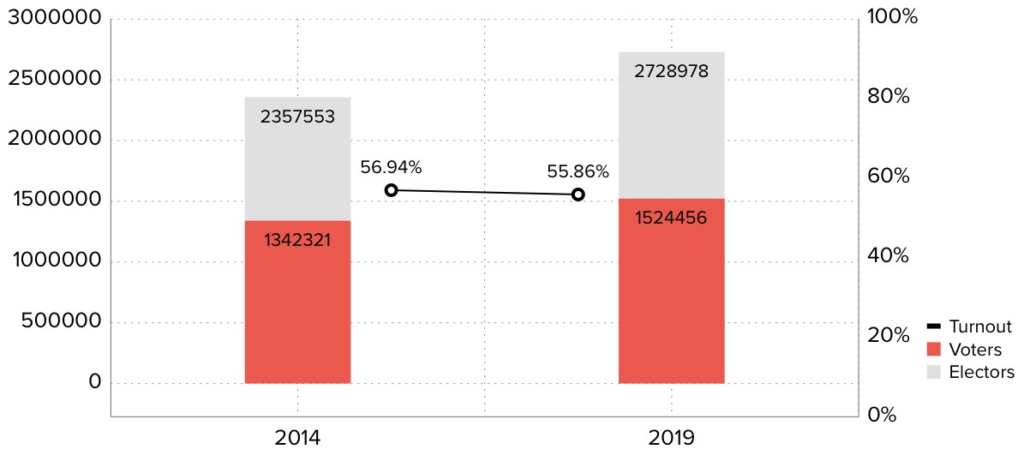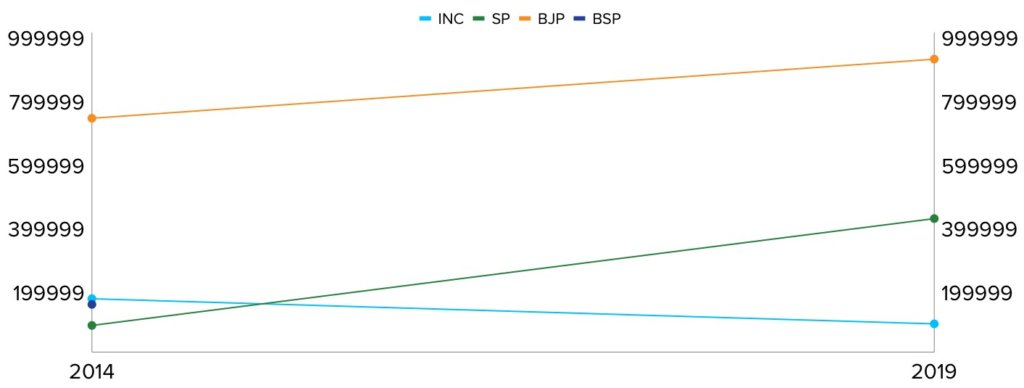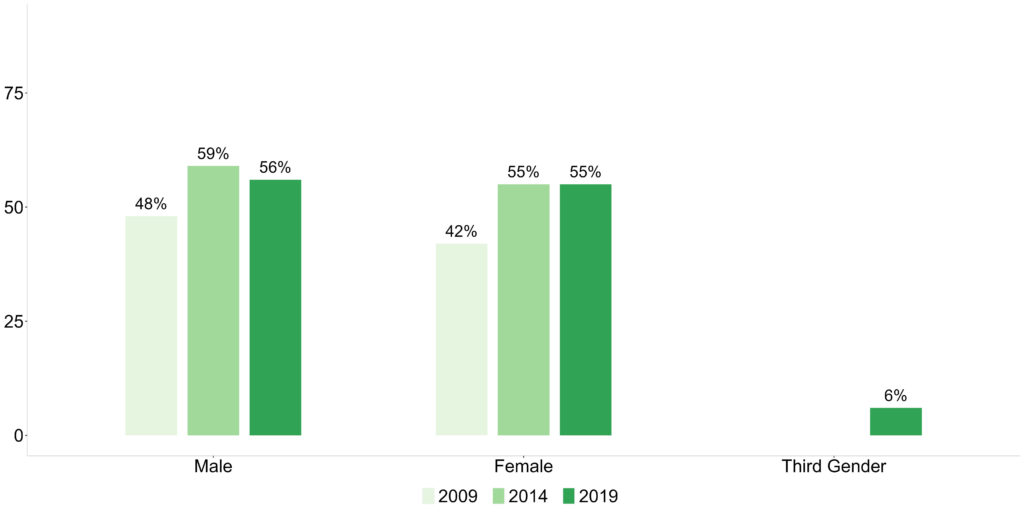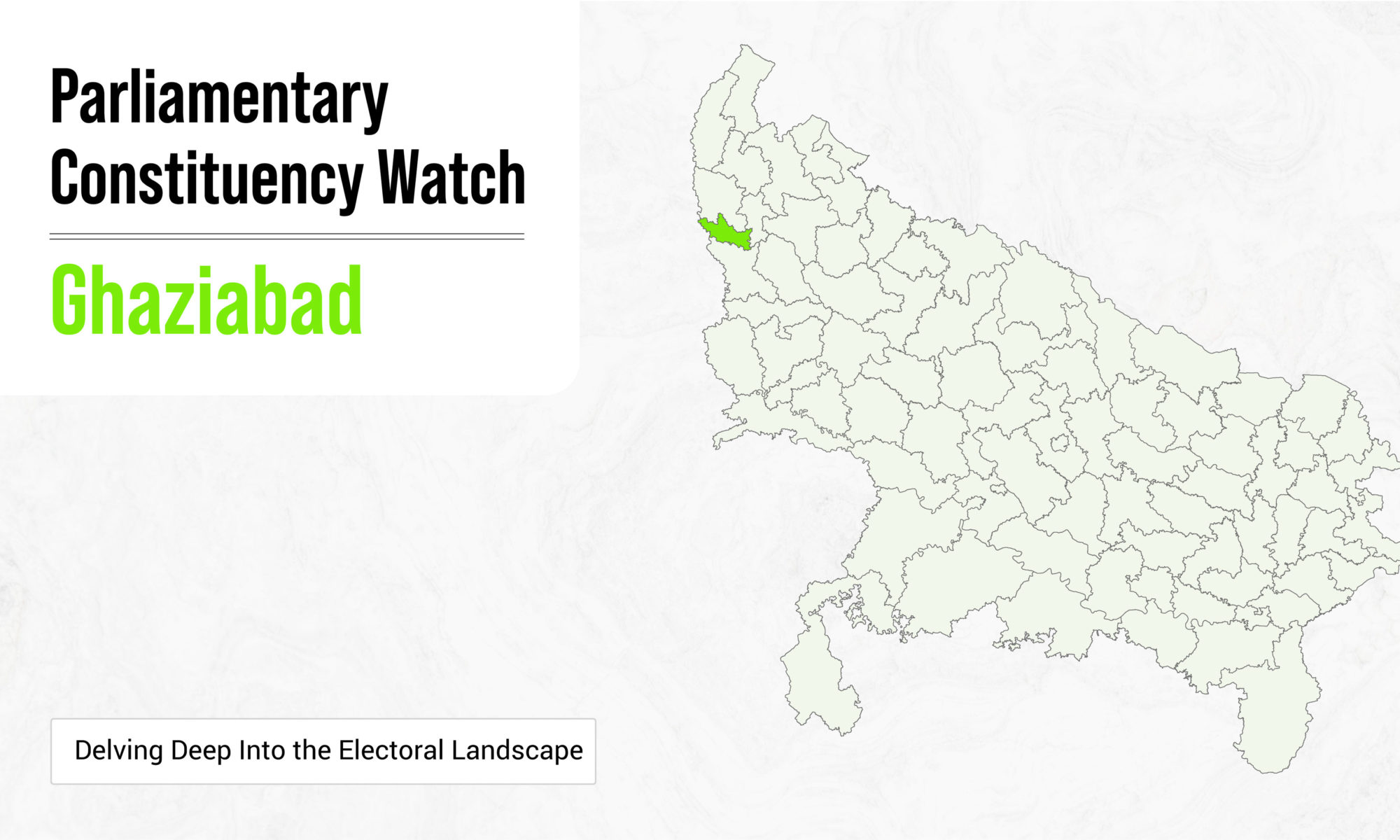Location
Ghaziabad Lok Sabha constituency is one of the 80 Lok Sabha constituencies in the Indian state of Uttar Pradesh. It comprises 5 assembly constituencies and 2 districts.
Category
Designated as a General Constituency.
Voter Turnout

Ghaziabad Electoral Turnout Rates
During the 2014 elections, the total number of electors was 23,57,553 and the turnout stood at 56.94%, in real numbers- 13,42,321 voters. 2019 witnessed a turnout decrease; out of the 27,28,978 electors, 55.86% of voters exercised their constitutional rights. In real numbers- 15,24,456 voters.
Representation and Results

Party Wise Vote Share
2019’s parliamentary election winner, BJP’s Vijay Kumar Singh gained a vote share of 62.00% and defeated SP’s Suresh Bansal whose vote share stood at 29.10%. The other prominent candidates in the fray were INC’s Dolly Sharma with a vote share of 7.30% and independent candidate Sewa Ram Kasana with 0.30% of vote share.
Voting History –2014 & 2019

Party Wise Shift in Votes
In 2014, BJP won the constituency and earned 7,58,482 votes followed by 9,44,503 votes in the 2019 election victory. On the other hand, SP garnered 1,06,984 votes in 2014 and 4,43,003 votes in the 2019 elections.
Parties at helm through the years

Timeline of Winning Parties
The Ghaziabad constituency came into existence in 2008 as a part of the implementation of delimitation of parliamentary constituencies based on the recommendations of the Delimitation Commission of India constituted in 2002.
In 2009, the Bahujan Janata Party (BJP) emerged as the leading political entity, capturing the electorate’s confidence in the newly minted Lok Sabha seat. Continuing its momentum, the BJP triumphed in the next two elections held in 2014 and 2019, reaffirming its popularity and consolidating its position as the prominent political force in the constituency.
Party-wise success rate

Success Rate
In terms of the success rate in securing the Ghaziabad Lok Sabha seat, BJP had exhibited complete dominance with a success rate standing at 100%.
Gender Wise Distribution of Contestants

Gender Wise Distribution of Candidates
During the 2009 elections, there were 16 contestants and all of them were male. In 2014, the total number of contestants decreased to 15, out of which 14 were male and 1 was female, in percentage- 93% and 7%.
In 2019, on the other hand, the total number of contestants further decreased to 12 whereby 10 were males and 2 females, in percentage that is 83% and 17% respectively.
Gender wise voter turnout
In 2009, out of a total of 18,30,096 electors, 8,29,493 voters cast their ballots. Of the 10,36,822 male electors, 4,97,410 participated in the election, constituting a turnout rate of 48%. There were 7,93,274 female electors and of that, 3,30,283 chose to vote with a turnout rate of 42%.
In 2014, there are 23,57,546 people who are eligible to vote and 13,42,320 of them chose to exercise their right to vote. Out of these, 13,33,051 were male electors and 10,24,495 were female electors. 59% of male electors (7,82,170) and 55% of female electors (5,60,150) cast their ballots.

Gender Wise Voter Turnout
The total count of electors in 2019 was 27,28,978 out of which 15,21,892 chose to cast their ballot in the parliamentary elections. Out of 15,19,938 male electors, only 56% voted which is 8,54,916 male voters in real numbers. On the other hand, the voter turnout for females stood at 55% which translates to 6,66,970 voters out of a total of 12,08,931 female electors in real number.
In 2017, transgender people were included as a separate category of the third gender in electoral rolls. There were 109 electors belonging to the third gender category in the parliamentary constituency during the 2019 elections. And 6 of them exercised their newly granted constitutional right to vote and thus their turnout stood at 6%.
Gender-Wise Literacy Rate
We are taking a peek at the gender-wise literacy rate of the Ghaziabad and Hapur districts which are part of the Ghaziabad parliamentary constituency as literacy is considered an essential indicator of the socioeconomic development of the region.
Ghaziabad District
The 2011 census of India has pegged the overall literacy rate of the Ghaziabad district at 69%. Gender-wise, the male literacy rate in the district is 74% whereas, for females, the literacy rate stands at 63%.

Gender Wise Literacy Rate
Hapur District
The overall literacy rate of the district is 61%. However, when it comes to gender, the literacy rate for males in the district stands at 69% while the female literacy rate is 52%.
Stay updated on the electoral statistics for parliamentary constituencies and the changing dynamics on Meradesh App. Available on Appstore and Play Store.
Reach your constituents, gain insights into their motivations, and build campaigns based on data-driven strategies with the Meradesh Platform.
Data Source – Meradesh.org
